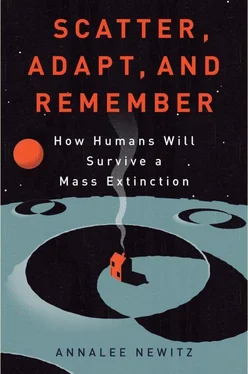So what would be an ideal response in the event of a pandemic? As soon as the WHO declares an outbreak, vaccines and at least two different kinds of medicines would be rushed to the most affected regions in order to stop the outbreak from becoming a pandemic. Children would be vaccinated first. If there were no vaccine available, scientists would immediately begin working on synthesizing one. Informal treatment stations would be set up in any region where there had been cases of the disease, so that people could be treated quickly, without bottlenecks. As individuals, we’d take great care to avoid big public gatherings and try to stay home as much as possible. Above all, we’d want coordination between health-care workers and pandemic modelers to figure out the best treatment strategy for each area, given the often limited resources we’ll have at hand.
The main thing to remember is that stopping a pandemic isn’t about treating individuals—it’s about treating groups who are the most likely to spread the pandemic to others. If your neighbor’s child gets a vaccine, this measure alone could protect your whole neighborhood more than if you and your adult friends all got vaccines.
Likewise, if we can kill a pandemic brewing in a developing country by sharing our vaccines and antivirals, we will save the developed world, too.
A global-health surveillance state would look very similar to the world we live in now, except there would be considerably more rapid sharing of information between groups you wouldn’t expect, such as Google and the CDC, or regional Chinese hospitals, mathematicians who model pandemics, and researchers at GlaxoSmithKline. Once a region began to exhibit signs of a flu outbreak, whether reported by doctors or revealed by searches on Google, the WHO would be alerted instantly. Pandemic modelers and vaccine manufacturers could respond with strategies for containment before a pandemic virus even had a chance to jump to a new city.
Anonymous health surveillance will be an integral part of pandemic-proof cities in the future. Combine surveillance with a good system for modeling pandemics and a supply of at least two antivirals, and you’ve got the blueprint for one of the healthiest cities the world has ever seen. And that’s the kind of city we could survive in for centuries. Unless, of course, we are dealing with a disaster that is so unusual, and so powerful, that we have no models for how it might work. All we can do in that case, as we’ll see in the next chapter, is go underground.
THERE ARE SOME disasters so catastrophic, and so rare, that we have very little data on them. Call them extreme radiation events. As we learned in chapter two, such an event may have caused the second-worst mass extinction on Earth 450 million years ago. Some scientists speculate that a gamma-ray burst coming from a nearby hypernova may have abruptly ended the Ordovician period, frying the ozone layer off our atmosphere and exposing the Earth’s newly diversified multicellular creatures to high doses of radiation. Creatures deep in the sea would have been protected by the radiation-absorbing water, but all the plants and light-loving swimmers near the surface would have been cooked instantly. Those not boiled to death would have been eaten away by radiation fairly quickly as the sun’s ultraviolet rays beamed down on the unshielded planet. A gamma-ray burst like that could hit the planet at pretty much any time, with very little warning. We would likely be able to see the hypernova with our naked eyes, and would have a few short hours before its stream of radioactive particles showered down on the Earth.
Such gamma-ray bursts are a very real threat, but they’re extremely unusual. Even less likely than a hypernova is the probability that its gamma-ray burst would be aimed directly at us. A far more likely cause of sudden radiation bombardment on Earth is human warfare. Even a limited nuclear war could pour ionizing radiation down on the planet in the form of nuclear fallout, causing radiation sickness in the short term and triggering cancers that could kill in the long term.
For people living in cities, it won’t matter if the radiation comes from space or nuclear bombs. To survive, we’ll need to go underground, into subterranean cities whose walls are made of thick layers of rock that can block radiation. We’ve known this for a long time. One of the greatest underground cities of the modern world, the NORAD (North American Aerospace Defense Command) complex beneath Colorado’s Cheyenne Mountain, was designed during the Cold War to protect up to 5,000 residents from atomic blasts and the subsequent fallout. But this isn’t the only underground city humans have built to protect themselves during war. Nearly two millennia ago in what is today central Turkey, Jews and Christians fleeing Rome built villages on top of vast underground cities that could protect thousands of people from Roman raiders—and later, from Muslims during the Crusades.
We’ve been surviving underground for a long time. And city planners today are building more and more underground structures. You may not think you have a chance of surviving during a radiation emergency, but you’re closer to an underground city than you think.
The mounded hills and deep, curving valleys of Göreme, Turkey, are famous for their beauty, and for thousands of undeniably phallic rock columns known as “fairy chimneys.” Though these structures elicit everything from giggles to New Agey declarations about “lingam power” from tourists, what’s most interesting about them isn’t their peculiarly erect shapes. Wind and water have worn them down in this way because the fairy chimneys, like the valleys and cliffs they emerged from, are made of tuff, a pale, crumbly rock composed of highly compressed volcanic ash. Early settlers in Göreme and many neighboring towns in Turkey’s Cappadocia region discovered that tuff was incredibly frangible, and easy to dig out and remold. Small groups of Judeo-Christian mystics driven out of Rome in the second century CE came to central Turkey to hide, and dug spartan monk’s cells into the tuff.
Over the next several hundred years, these tiny settlements of hermits and outcasts grew. Villagers carved out homes, churches, and vast food-storage pantries, eventually creating a breathtaking architectural style in which gorgeous classical columns and arched church doors appear to emerge from solid rock. Local aristocrats funded incredible subterranean art projects, deep cave churches whose high ceilings are painted with gorgeous biblical scenes that could only be seen in torchlight. Many of the most awe-inspiring examples are still preserved in Göreme’s Open Air Museum, a cluster of churches and monasteries carved into the creamy tuff above a valley full of patchwork farms. From a distance, the ornate, sculpted complex looks like an otherworldly city from a Lord of the Rings movie. During the Byzantine era, however, the need for these cave and tunnel cities was all too real.
Cappadocians built dozens of underground cities in the era between the fifth and tenth centuries. Historians have conflicting theories about why, but one major reason would no doubt have been raids from neighboring groups and from Muslims during the Crusades. These underground cities don’t just shield inhabitants from the elements—their entrances are hard to reach, or hidden. They are designed to be invisible.
To imagine how future humans might survive a radiation disaster underground, we need only pay a visit to subterranean Cappadocia. On a drizzly day spent near Göreme, I ducked out of the summer rain to visit Derinkuyu, the most extensive of the excavated underground cities in the region. Now open for tourists, the city’s maze of tunnels, living quarters, and community areas extends five levels and 55 meters underground. Cool and sandy, its often cramped corridors are well ventilated by several air shafts. My tour group and I squeezed down a long stairway, then entered a large room that was once a stable. It could easily have housed a dozen goats, sheep, or cows, chomping contentedly from mangers carved right into the walls. Our guide pointed out that villagers typically entered Derinkuyu via secret tunnels from their aboveground homes. These entrance tunnels were small enough in many places that I was forced to bend quite far down as I walked, and I’m a fairly short person. The city’s builders engineered these areas to discourage anyone trying to enter with bulky weapons or armor. Punctuating many of the stairways were deep crevices that held enormous rock discs designed to roll out and block the corridor from invaders.
Читать дальше






![Аннали Ньюиц - Автономность [litres]](/books/424681/annali-nyuic-avtonomnost-litres-thumb.webp)





